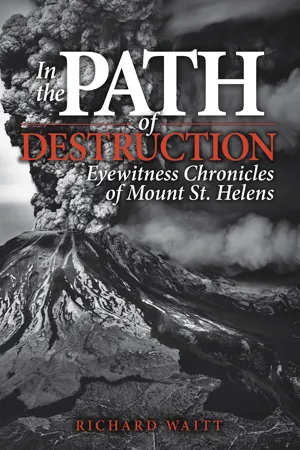
- 424 pages
- English
- ePUB (mobile friendly)
- Available on iOS & Android
About This Book
A napping volcano blinked awake in March 1980. Two months later, when that mountain roared, Jim Scymanky was about twelve miles northwest, logging a north slope above Hoffstadt Creek. "Rocks zinged through the woods, bouncing off trees, then the tops of trees snapped off… Suddenly I could see nothing…it got hot right away, then scorching hot and impossible to breathe. The air had no oxygen, like being trapped underwater…I was being cremated, the pain unbearable."
Steve Malone, at the University of Washington Seismology Laboratory, was inconsolable. "We'd failed. For two months we'd counted and located thousands of earthquakes, looked for changes to anticipate an eruption. Then it just happened. It killed many people. It killed David Johnston. We could hardly work."
Author Richard Waitt was part of a U.S. Geological Survey team doing volcano research in the Cascades, and was one of the first to arrive following the mountain's early rumblings. His journey collecting eyewitness accounts began with a conversation in a bar the third week after Mount St. Helens erupted. The couple he met barely outraced a searing ash cloud, and Waitt realized their experiences could inform geologic studies. He eventually conducted hundreds of interviews--sometimes two and three decades later--often making multiple visits to gather additional details, correct errors, and resolve discrepancies.
A meticulous scientist with intimate knowledge of Mount St. Helens, Waitt delivers a detailed and accurate chronicle of events. He tapped numerous primary sources--interviews, legal depositions, personal diaries, geologists' field notes, radio logs, and police records. Newspaper stories and even sun shadows on photographs revealed additional intricacies. In the Path of Destruction's eruption story unfolds through unforgettable, riveting narratives--the heart of a masterful chronology that also delivers engrossing science, history, and journalism.
Frequently asked questions
Information
Table of contents
- Cover
- Half Title
- Title
- Copyright
- Contents
- The Stick
- Before
- The Fuse Is Lit, But We Don’t Know How Long It Is: Anatomy of Crisis
- Let’s Get the Hell Out of Here!
- 18 May 1980
- It’s a Totally Different World: Aftermath
- Appendix I: Cast of Characters
- Appendix II: Sources and Methods
- Appendix III: Summary of Interviews 1980–2014
- Notes
- References
- Index